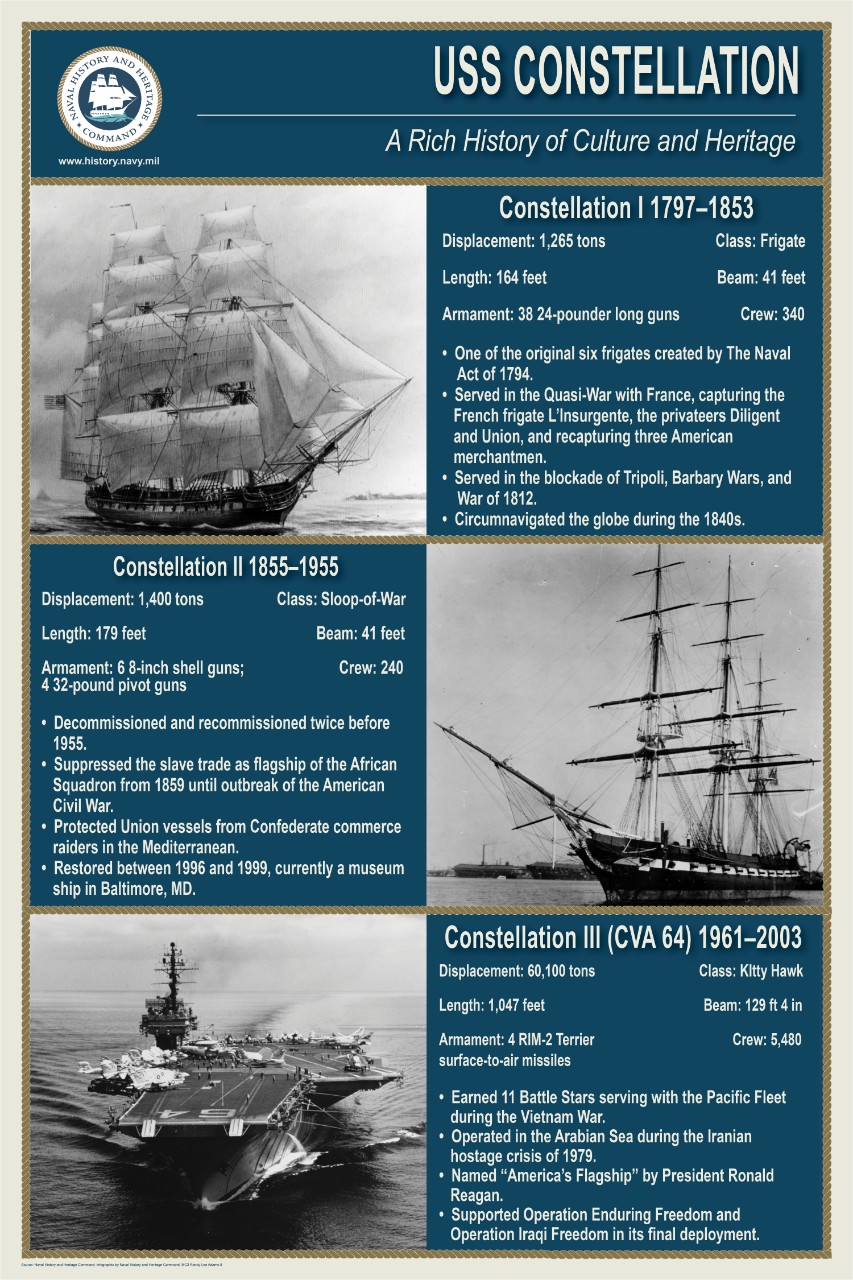Frigate Constellation
Action between U.S. frigate Constellation and French frigate L’Insurgente, 9 February 1799. Painting by Rear Admiral John W. Schmidt depicting Constellation (at left) taking position ahead of L’Insurgente. After the more than one-hour engagement, the badly outmaneuvered and damaged French frigate surrendered. Captain Thomas Truxtun was the commander of Constellation during the engagement. (KN-2882)
Frigate Constellation—designed by naval constructors Joshua Humphreys and Josiah Fox whose plans were altered in the execution by builder David Stodder and superintendent of shipbuilding Captain Thomas Truxtun—was constructed at the Sterrett Shipyard in Baltimore, Maryland. It was launched on 7 September 1797. The ship was one of six frigates authorized by Congress with passage of the Naval Act of 1794. Under the command of Truxtun, Constellation set sail for the Caribbean and subsequently the West Indies to protect U.S. commerce. On 9 February 1799, the ship spotted French 40-gun frigate L’Insurgente off Nevis. In a hard fought battle that lasted a little more than hour, Constellation defeated the French ship and took it as a prize. In the following months, Constellation also seized French privateers Diligent and Union. On 1 February 1800, the American frigate engaged 52-gun frigate L’Vengeance in a lengthy, furious battle. Although the French ship twice struck its colors and nearly sank, it managed to escape under the cover of darkness. In the ensuing months, success continued for Constellation when in May it recaptured three American merchantmen. At the conclusion of the Quasi War with France, the ship set sail for home waters, but misfortune awaited the gallant ship. While anchored in Delaware Bay on 10 April 1801, the ship was caught in heavy seas that laid it over on beam ends. After it was recovered, Constellation underwent extensive repairs.
In May 1802, Constellation sailed with the squadron of Commodore Robert Morris, and later with Commodores Samuel Barron and John Rodgers, participating in the blockade of Tripoli. It cruised extensively in Mediterranean waters to show the flag in demonstration of United States seapower, and in June, evacuated a contingent of U.S. Marines, as well as diplomats, from Derne at the conclusion of fleet-shore operations against Tripoli. After peace terms were finalized, Constellation returned to the United States arriving in Washington, DC., in November 1805 where it was placed in ordinary until 1812.
With the advent of war with England, Constellation, under the command of Captain Charles Stewart, set sail for Hampton Roads, Virginia. Shortly after arrival in January 1813, it was effectively blockaded by the powerful British fleet. Although it was unable to reach the open sea, Constellation’s presence helped protect fortifications at Craney Island. In the aftermath of the War of 1812, Barbary powers had enriched themselves considerably during America’s struggle with Britain. On 20 May 1815, Constellation—attached to the Mediterranean Squadron under Commodore Stephen Decatur, Jr.—sailed from New York and joined in the capture of Algerian frigate Mashuda on 17 June 1815. Soon after peace treaties ensued with Algiers, Tunis, and Tripoli, Constellation remained with the squadron to enforce the accords, returning to Hampton Roads in December 1817.
Except for brief periods of repair work, Constellation’s career through the mid-19th century was wide-ranging and colorful. From late 1819 through April of the next year, Constellation served as flagship for Commodore Charles Morris on the Brazil Station, where they protected American interests against privateers and also helped negotiate trade agreements with South American countries. On 25 July 1820, Constellation, for the first time, set sail for Pacific waters, where it remained for the next two years protecting American shipping off the coast of Peru. In 1827, Constellation served briefly as flagship of the West India Squadron whose mission was the eradication of pirates and the interception of slavers. In August 1829, Constellation cruised to the Mediterranean where it stood watch over American shipping and collected indemnities from previous losses suffered by U.S. merchantmen. The ship returned to the United States in November 1831, and underwent repairs before it set sail again for the Mediterranean remaining there until November 1834. Constellation was forced to return to the United States due to an outbreak of cholera among the crew. In October 1835, Constellation hoisted its sails for the Gulf of Mexico to assist with the Seminole uprising. It landed shore parties to relieve the Army and sent its boats on amphibious expeditions.
During the 1840s, Constellation circumnavigated the globe and served on the East India Squadron where its mission was to safeguard American lives and property against loss during the Opium War, and further, to enable negotiation of commercial treaties. In May 1843, while enroute to homeport, it made way to the Hawaiian Islands to protect them from becoming a British province, and thereafter, made port calls to several South American destinations. Constellation was ultimately laid up in ordinary at Norfolk for more than a decade before the gallant old frigate was broken up in 1853.
*****
Suggested Reading
- The Birth of the U.S. Navy
- The Reestablishment of the Navy, 1787–1801: Historical Overview and Bibliography
- Launching the New Navy
- Age of Sail
- Pirate Interdiction and the U.S. Navy
- The Fates of the Six Frigates Created by the Naval Act of 1794
- NAVSEA Dedicates Building to Historic Shipbuilder
- SECNAV Names Navy’s Newest Class of FFG(X) Ships
Infographic
Selected Imagery
An Act to Provide a Naval Armament was adopted by the Third Congress of the United States in response to the depredations committed by Algerine corsairs on the commerce of the United States. It was approved on 27 March 1794. The act authorized acquisition of ships, commissioning of officers and raising of crews, and specifies ship manning levels, pay and rations. The document was signed by Frederick Augustus Muhlenberg (Speaker of the House of Representatives), Vice President John Adams (President of the Senate) and President George Washington. (NH 85796)















